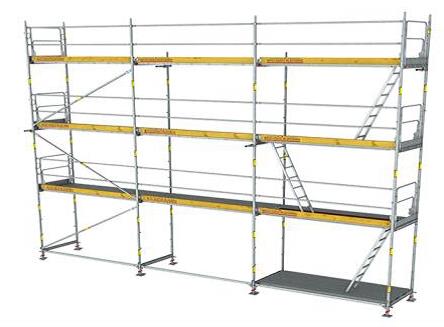
 Buildings311
Buildings311 Search all NYC.gov websites
Search all NYC.gov websites
Project Categories: Construction Equipment - Scaffold
Construction equipment projects involve installation of equipment to support construction activities or to secure a construction site for protection of workers and the general public. Construction projects may include erection of a new building or the alteration, renovation, remodel, or renewal of an outdated or damaged existing structure and associated materials, including any partial or full demolition. These projects may require construction equipment such as scaffolding during the project’s execution.
Scaffold is a temporary elevated platform, including its supporting structure, erected at a construction site during construction to support workers and/or materials and providing aboveground access to the building’s exterior. A scaffold may also serve as a frame for installing safety netting. In New York City, scaffolds may be erected over a sidewalk shed, which protects pedestrians from potential debris when construction work on higher floors occurs above the sidewalk.
Types of Scaffolds
- Supported scaffold: One or more platforms supported by outrigger beams, brackets, poles, legs, uprights, posts, frames (including prefabricated frames that are mechanized but not motorized) or any similar rigid support including, back structures connecting hoistways to buildings and structures with integral sidewalk protection.
- Suspension scaffold: A platform(s) suspended by more than two ropes from overhead supports, equipped with a means to raise and lower the platform to desired work levels, providing access and working platforms during construction. Suspended scaffolds are also used for inspection, refurbishment and maintenance of high-rise buildings, industrial plants, or other large structures.
- Mobile scaffold: A powered or unpowered, portable caster, track or wheel-mounted supported scaffold. Mobile scaffolds are generally braced on all sides and to prevent the installation from deforming in shape. Mobile scaffolds can be erected from a variety of components or systems, including prefabricated systems (aluminum or fiberglass); steel frame scaffolds (H frame); modular steel scaffolds; or tube and fitting scaffolds.
Typical Scaffold Components
- Platform: An elevated work surface constructed of individual wood planks, fabricated planks or fabricated decks.
- Supporting Structures: Outrigger beams, brackets, poles, legs, uprights, posts, and frames, including prefabricated frames, which are mechanized but not motorized. Support may include any similar rigid support, including back structures connecting hoistways to buildings.
- Outrigger Beam: Structural members of a suspended scaffold or outrigger scaffold that provide support by extending the scaffold point of attachment out and away from the structure or building.
- Guardrail System: A vertical barrier consisting of, but not limited to, top-rails, mid-rails and posts, erected to prevent falling from a scaffold platform or walkway to lower levels.
- Sidewalk Protection: Scaffold and its supporting structure may include integral apparatus for sidewalk protection.

Typical Scaffold Scope of Work
- Initial installation: The initial assembly, set-up, or placement of a scaffold at a site.
- Reinstallation: The addition, relocation, or removal of any part, component, or attachment to a scaffold at a site, including but not limited to counterweights, tie-backs, anchorages, or connections to the building or structure, that occurs subsequent to the initial installation and which does not otherwise occur in an automated, automatic fashion, as part of the normal use of the scaffold.
- Removal: The final dismantling of the scaffold and its removal from a site.
- In New York City, scaffolds may be installed either inside the building, on the property, or outside of the property on adjoining streets or sidewalks. Installations on a public street or sidewalk require a permit from the Department of Transportation (DOT) and approval from other agencies/utilities such as the Department of Environmental Protection (DEP), MTA, Con Edison, etc.
In New York City, scaffolds may be installed either inside the building, on the property, or outside of the property on adjoining streets or sidewalks. Installations on a public street or sidewalk require a permit from the Department of Transportation and approval from other agencies/utilities such as the Department of Environmental Protection, MTA, Con Edison, etc.
Project Notes:
- Prior to submittal, applicants must review existing construction equipment installations and include locations for ALL existing equipment/devices on the property with the construction document submissions.
- A supported scaffold with netting and guardrails may be utilized as an alternative to horizontal safety netting.
Project Categories:
-
Alterations COMING SOON!
-
Demolition COMING SOON!
-
New Buildings COMING SOON!


